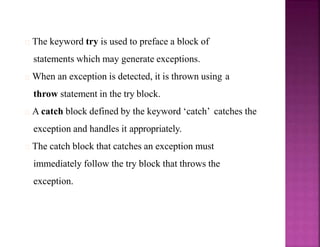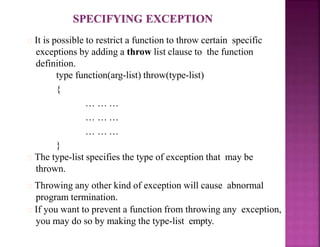C++ ala
- 2. Exceptions are run time anomalies or unusual conditions that a program may encounter during execution. Conditions such as ● Division by zero ● Access to an array outside of its bounds ● Running out of memory ● Running out of disk space It was not a part of original C++. It is a new feature added to ANSI C++.
- 4. Exception handling mechanism ● Find the problem (Hit the exception) ● Inform that an error has occurred (Throw the exception) ● Receive the error information (Catch the exception) ● Take corrective action (handle the exception)
- 5. It is basically build upon three keywords ● Try ● Throw ● Catch try block Detects and throws an exception catch block Catch and handle the exception Exception object
- 6. The keyword try is used to preface a block of statements which may generate exceptions. When an exception is detected, it is thrown using a throw statement in the try block. A catch block defined by the keyword ‘catch’ catches the exception and handles it appropriately. The catch block that catches an exception must immediately follow the try block that throws the exception.
- 7. try { … throw exception; … } catch(type arg) { … … … } /* Block of statements which detect and throws an exception */ // catch exception /* Block of statement that handles the exception */
- 8. Exceptions are objects used to transmit information about a problem. If the type of the object thrown matches the arg type in the catch statement, the catch block is executed. If they do not match, the program is aborted using the abort() function (default). Often, Exceptions are thrown by functions that are invoked from within the try blocks. The point at which the throw is executed is called the throw point. Once an exception is thrown to the catch block, control cannot return to the throw point.
- 9. Invoke function try block Invokes a function that contains an exception catch block Catch and handle the exception throw point Function that causes an exception Throw exception
- 11. The throw statement can have one of the following 3 forms ● throw(exception) ● throw exception ● throw //used to re-throw a exception The operand object exception can be of any type, including constant. It is also possible to throw an object not intended for error handling. Throw point can be in a deeply nested scope within a try block or in a deeply nested function call. In any case, control is transferred to the catch statement.
- 13. The type indicates the type of exception the catch block handles. the parameter arg is an optional parameter name. The catch statement catches an exception whose type matches with the type of the catch argument. catch(type arg) { … … … }
- 14. If the parameter in the catch statement is named, then the parameter can be used in the exception handling code. If a catch statement does not match the exception it is skipped. More than one catch statement can be associated with a try block.
- 15. try { throw exception; } catch(type1 arg) { // catch block 1 } catch(type2 arg) { // catch block 2 } … … catch(typeN arg) { // catch block N }
- 16. When an exception is thrown, the exception handlers are searched in order for a match. The first handler that yields a match is executed. If several catch statement matches the type of an exception the first handler that matches the exception type is executed. Catch all exception catch (…) { // statement for processing // all exception }
- 18. A handler may decide to rethrow the exception caught without processing it. In such a case we have to invoke throw without any arguments as shown below ● throw; This causes the current exception to be thrown to the next enclosing try/catch sequence and is caught by a catch statement listed after the enclosing try block. It is possible to restrict a function to throw certain specific exceptions by adding a throw list clause to the function definition.
- 19. It is possible to restrict a function to throw certain specific exceptions by adding a throw list clause to the function definition. type function(arg-list) throw(type-list) { … … … … … … … … … } The type-list specifies the type of exception that may be thrown. Throwing any other kind of exception will cause abnormal program termination. If you want to prevent a function from throwing any exception, you may do so by making the type-list empty.



















